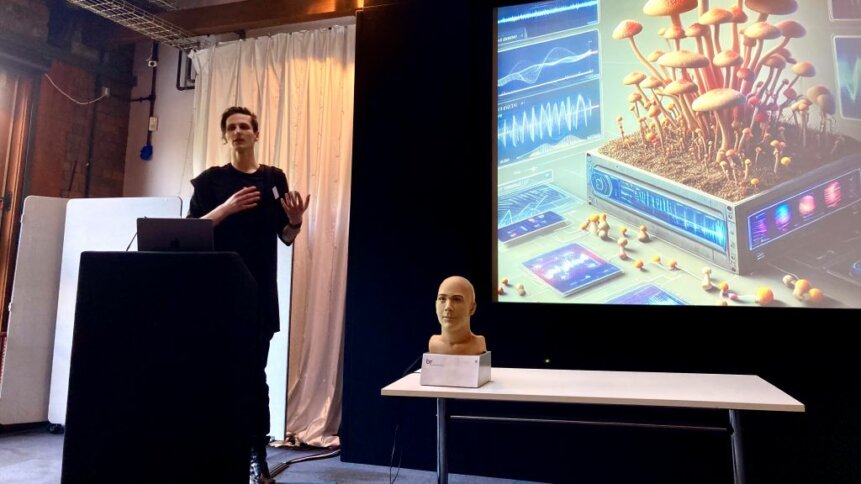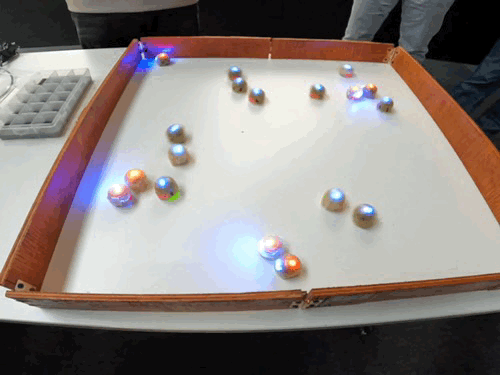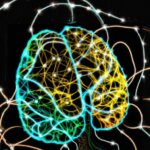Considering the future of computing – chemical AI and beyond

|
Getting your Trinity Audio player ready...
|
Despite the sky-high demand for GPUs – thanks to a boom in generative AI – you won’t discover the future of computing by listening to an NVIDIA earnings call. Finding out what’s on the edge of possible comes from sources outside the usual cluster of big tech firms. And for a handful of days, many of those unconventional computing experts were gathered in Bristol, UK, just a short walk from TechHQ’s main office.
Taking an unconventional route to visiting Unconventional Computing Bristol 2023. Video: JT.
The workshop was held under the aegis of COGITOR and FUNGATERIA – two forward-looking, EU-funded projects that radically re-think how information can be processed and provide an intriguing glimpse into the future of computing.
By definition, unconventional computing almost defies trend. However, looking closely at the ideas being brought to the table – and there are some brilliant ones inspired by the behavior of soldier crabs and utilizing cultivated fungal networks – it’s possible to see patterns.
Nature’s computers have some common elements, such as oscillators, and numerous examples in the natural world prove that these components don’t have to be engineered in silicon. Jerzy Gorecki, presenting his results in the opening session of Unconventional Computing Bristol 2023 – which was chaired by Andrew Adamatzky, a well-known figure in the field and organizer of the workshop – highlighted the prospects for computing with chemical oscillators.
Propagating chemical waves can quickly find the shortest path in a maze – a reaction-diffusion computing process dubbed the prairie-fire algorithm. And, in another of the opening day’s presentations – discussing advances in chemical AI – Pier Luigi Gentili reminded the audience of how neurons in the brain rely on propagating chemical waves. Such mechanisms may play a role in consolidating our memories during sleep, and point to how chemistry is inspiring advances in the future of computing.
Rather than use larger fluidic systems, some researchers working in chemical AI are choosing to go small and build from the bottom up. Shin-Ichiro Nomura, who’d travelled to the event from Japan, discussed the creation of molecular auto-matter – tiny molecular robots (or molbots) that can be instructed using UV light.

Genaro J. Martinez from the School of Computer Sciences, National Polytechnic Institute, Mexico City, demonstrated how complex systems can evolve from just a few simple rules. 1/2 speed GIF: JT.
Describing some of the practical uses of chemical AI, Gorecki outlined an approach for implementing neural networks using chemical reactions to solve certain types of classification problems.
Wetware (adding to the concepts of hardware and software) could end up playing a major role in the future of computing. Modeling shows that just three chemical oscillators can achieve 98% accuracy, and applications include determining whether a certain drug will be effective for a patient by learning from gene expression data.
As well as the need for oscillators – for example, to engineer pulses – it might be surprising to learn that another important element of future computing platforms could include noise. Typically perceived as negative in conventional electronics, noise can have positive benefits in biological systems.
Speaking to TechHQ during lunch on day one of the workshop, Victor Erokhin – who’s long been studying the fundamentals of organic neuromorphic systems (in other words, computer systems inspired by the structure and function of the human brain) – painted a useful thought picture of why noise is beneficial in nature.
Imagine you have a series of valleys representing possible solutions to a problem, with a marble resting inside one of those minima marking the current answer. Noise shakes up the system so that the marble can traverse into the deepest valley, allowing the system to identify the most favorable solution.
Cellular automata navigate logic gates – earlier work by Genaro J. Martinez.
A popular talking point over the two days, was the idea of reservoir computing – which could be a much more efficient way of implementing AI methods. Rather than having a deep neural network in software with many layers and billions of parameters (the weights that cause artificial neurons to fire when they see a picture of a dog, but not a cat, for example) researchers are coupling inputs and outputs to a central reservoir, which can take a number of forms.
One option is to use memristors – a technology combining memory storage and information processing. The thinking is that a memristor array could capture the complexity of a neural network in hardware – for example, with resistances at different nodes analogous to the model weights. And it opens the door to some clever signal processing, in theory.
In practice, as Konrad Szacitowki – a chemist who’s been busy investigating new memristive materials – pointed out, getting memristors to behave consistently is a challenge. That being said, the technology tempts a fascinating alternative to the giant AI models of today. And there are some early designs on the market, such as memristor chips by KNOWM that allow developers to experiment with a possible future of computing.
Reservoir computing can be engineered in other ways too – for example, using programmable magnetic liquids. “It’s possible to program the system to recognize digits,” Alessandro Chiolerio – coordinator of Project COGITOR and part of IIT’s Bioinspired Soft Robotics group – told the audience, updating attendees on advances in colloid computing.
Liquid-state cybernetics and dice-rolling bacteria
The COGITOR project has ambitions to prototype a liquid-state cybernetic system capable of providing memory, computing, pressure sensing, and energy harvesting (from thermal gradients). One of the reasons for taking an unconventional computing approach is to engineer a system capable of surviving extreme environments for potential applications in space.
Testing has shown that the ferrofluid used by the team to enable in-memory computation is capable of at least 10 million endurance cycles. And Chiolerio explained that the amorphous nature of the solid-state device makes it extremely robust, raising the prospect of long lifetimes.
There’s no shortage of candidates when it comes to the future of computing, and keeping an open mind is key to discovering solutions that may be off the radar to many people. On this theme, Dan Nicolau – a mathematician and medic who’s been looking at ways of using bacteria to solve difficult maths problems encoded in structures – revealed a novel technique for generating random numbers.
True random number generation (TRNG) is harder than you may think. Unpredictability is key to providing security through cryptographic systems, and if adversaries know anything about the seed, they can potentially work backward to break the code.
Nicolau has built a working chip that encases bacteria in a recirculating design, which presents the microorganisms with a maze of split junctions. Random numbers (the unpredictability of the process has been validated by NIST testing) are produced according to the decisions of bacteria to go left or right as they journey through the grid of channels, which gives TRNG output at very low energy cost. Plus, the setup has another enticing feature.
Because bacteria can pass over each other in the channels, it’s possible on occasion for the binary result at a junction to be both zero and one. In the TRNG configuration, these results are rejected. But anyone who’s peeked into the world of quantum computing will know that superposition (the ability of a quantum bit to be both zero and one) opens the door to new ways of problem-solving.
DNA puts a new spin on SQL
Looking at other topics on the agenda, the future of computing could also take an interesting turn when it comes to data storage. Natalio Krasnogor leads a multidisciplinary research group that’s investigating DNA as an alternative to today’s digital archiving media. DNA is stable and can last for thousands of years under the right conditions. And perhaps its biggest attraction for use in IT is data density – a single gram of DNA is said to be able to store in the region of 215 petabytes of data, which is enough to accommodate well over 30 million HD movies.
So far so good, but – as Krasnogor points out – there’s the issue of cost. He reports that the current cost to store 1 MB in DNA is around US $900, which puts the price at around $900 million for 1 TB of storage, compared with around $60 if you simply used a commercial SSD.
However, computing technology has a reliable habit of becoming cheaper over time, as methods scale and move from the lab to the fab. And there’s another reason why DNA might succeed in the longer term. Molecular data structures, while they may not be fast, provide opportunities for compute as well as storage.
This means that DNA archives could offer data processing opportunities. Imagine information storage hardware that could understand SQL queries, and you’re heading in the direction that Krasnogor, and others, believe could be a sweet spot for the novel approach.
Attending an unconventional computing workshop offers many clues about the nature of next-generation information systems, such as designs capable of harnessing the embodied intelligence of plants. Plants are self-assembling, self-repairing, biodegradable, solar-powered, and certainly worth taking a look at when considering the longer-term future of computing.
Fungal networks controlling robots
One of Andrew Adamatzky’s claims to fame in the unconventional computing arena is recognizing the potential of slime mold – commonly found in forest settings – to address complex logistics and transportation issues. If you want to discover the shortest possible route to visiting a number of destinations exactly once and return to your origin (the so-called ‘traveling salesperson’ problem, which has to be approximated when run on classical computers) – slime mold can give you the answer in just a few hours.
Given his successful track record, when Adamatzky and his research partners bring up the topic of using fungal networks to control robots, it’s worth paying attention. Underpinning this fascinating perspective on the future of computing is the fact that fungi show spiking neuron behavior reminiscent of action potentials in the brain.
Interested in:
1) #Fungal #biofabrication
2) Conductive #functionalisation of fungal#mycelium
3)Fungal #computing
….and how all this gets integrated into:
4) #Architectural #design?Then read our latest #OpenAccess research article here: https://t.co/pOS9wdSVbA pic.twitter.com/oTV1I0I8SA
— Phil Ayres (@philayres_) February 1, 2021
Specifically, it’s the root-like structure (mycelium) – which can extend for tens of kilometres between fungal colonies – that provides this highly prized, but as yet little understood property. Researchers are recording these spikes to try to determine how fungi communicate so that they can potentially tap into the conversation to perform computing tasks.
Demonstrations at the workshop included a robot capable of moving its mouth in response to signals derived from mycelium. Another team is trying to picture fungal dreams using generative AI. And while these pursuits may sound far-fetched, it’s worth considering projects elsewhere in other fields, such as CETI that’s trying to understand what whales are saying.
Fed with training data, AI can embed similar words close to each other and geometrically map context such that ‘man to king’ resembles ‘woman to queen’. And those relationships are strikingly similar across different human languages, which raises the question of whether AI can tease out information from other species and even plants.
“Our goal is real-time dialog between natural and artificial systems,” Ugnius Bajarunas, a member of Adamatzy’s team told the audience, noting that it’s an ambitious and challenging project.
What will computers be like in 2050?
Looking back 30 years, and it’s striking how far computers have come in design and performance. Small, yet powerful, smartphones with pin-sharp, full-color displays in form factors that fit in your pocket with wireless connectivity wouldn’t be how you’d describe computers in the 1990s. Instead, device users had to make do with brick-like laptops, which made portable computing possible, but would be no match for today’s mobiles.
The common link between then and now is having processors based on silicon. However, projecting forward to 2050 and listening to what workshop attendees had to say, it feels like progress will be made along a variety of lines, not just following tracks laid down in silicon.
Presentations at Unconventional Computing Bristol 2023 have shown that answers to the question ‘What will computers be like in 2050?’ could include logic derived from wildly different sources. In fact, one of the sessions even raised the question of being able to perform computing with a rock. Keeping an open mind throws a whole new light on how to identify the future of computing and harvest it.










